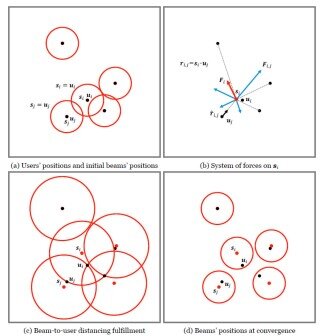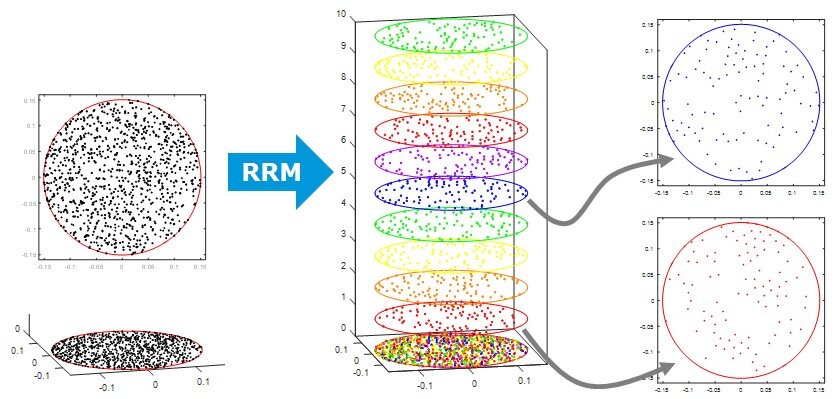Heuristic Radio Resource Management for Massive MIMO in Broadband Communication Satellites
| 783 - Abstract: |
| The present invention relates to the design of low-complexity heuristic solutions for Radio Resource Management (RRM) in very high efficient telecom satellite payload combining flexibility and high throughput. It provides a simple heuristic RRM for pragmatic M-MIMO achieving Mixed Integer Quadratic Programming (MIQP) performance, which is very robust to non uniform traffic different distributions. ESA is looking for partners who would be interested in licensing and implementing this patent. |
Description:
The need for higher throughput, hence large frequency reuse, in point-to-point satellite communications has triggered the exploitation of payloads with a large number of beams and the development of associated technologies. While the increase of the number of satellite beams is beneficial in terms of achievable frequency reuse and antenna gain, its practical adoption creates a number of system-level issues. The main challenge is related to the non-uniform nature of traffic seen by a satellite with large coverage area. This is because the satellite broadband access services are playing a complementary role to terrestrial networks. Hence, satellite use is mainly related to under-served regions such as low-densely populated areas, maritime and, aviation routes over non populated areas (e.g., oceanic routes). To cope with this spatially uneven and time variant traffic distribution over the satellite coverage area, a number of technologies to support flexible payload resource allocation have been devised and are continuously improved.
Regardless of any recent advancements in the field, there is a need for practical techniques for adopting M-MIMO in communication networks, such as broadband satellite networks. There is particular need for such techniques that require reduced computation power and/or that can accommodate for higher numbers of
user terminals.
In this sense, the present invention is related to the design of low-complexity heuristic solutions for Radio Resource Management (RRM) in very high efficient telecom satellite payload combining flexibility and high throughput.
ESA PAT 764 was dealing with a pragmatic solution to implement Massive Multiple-Input Multiple Output with limited complexity in terms of payload on-board signal processing. The current invention discloses a methodology drastically simplifying the NP-hard Mixed Integer Quadratic Programming (MIQP) RRM algorithm. It is shown that the proposed heuristic RRM method has performance very close to the MIQP with a combinatorial and computational complexity linearly (instead of exponential and quadratic, respectively) dependent on the number of users. The heuristic RRM proposal aiming at optimally organising the active users’ population in the system colours (slices in time (in the preferred embodiment), frequency or code) can be further enhanced by a further beam selection optimization step based on a newly disclosed technique named “virtual distancing”. The proposed heuristic RRM solution can be easily implemented using the current DVB-S2X standard and perfectly match the Multi-Beam M-MIMO simplified payload architecture proposed in ESA PAT 764. Although the proposed heuristic RRM and virtual distancing techniques are particularly suited for the pragmatic M-MIMO solution disclosed in ESA PAT 764 they can also be used in other (more conventional) multi-beam satellite systems.
Through extensive computer simulations, the heuristic RRM and virtual distancing techniques have been applied to the pragmatic M-MIMO multi-beam satellite system in the presence of many non-uniform and uniform (as best case) traffic scenarios. The performance are shown to be only slightly below to ideal M-MIMO exploiting Minimum Mean Square Error (MMSE) precoding with ideal channel estimation for all traffic cases investigated. In practice, this performance is not achievable, thus remaining a purely theoretical benchmark while the proposed heuristic RRM on top of the pragmatic M-MIMO approach is readily feasible.
Simulation results show a truly remarkable RRM algorithm robustness to very different traffic scenarios and allowed to understand the system throughput performance dependency on key system parameters (e.g. the current traffic over satellite maximum coverage area ratio and the number of array elements over the active users’ ratio).
Innovations and advantages:
- Simple heuristic RRM for pragmatic M-MIMO achieving MIQP performance
- Robust to non uniform traffic different distributions
- Easy to implement on current DVB-S2X standard and on PAT 764 flexible pragmatic M-MIMO payload.
Domain of application:
The invention is relevant to radio resource management of the satellite telecom system and can be used for satellite telecommunication programs with possible spin-off in terrestrial wireless systems (5G and beyond). It is relevant to radio resource management of the satellite telecom system.
In addition, fixed point to multipoint terrestrial links may benefit from the invention.
For additional information, please refer to the following paper published in IEEE by the inventors:
Heuristic Radio Resource Management for Massive MIMO in Satellite Broadband Communication Networks
Authors: Piero Angeletti, Riccardo de Gaudenzi.



